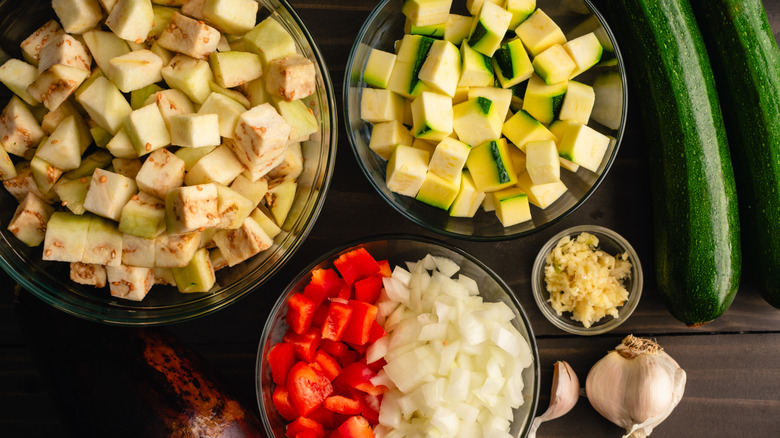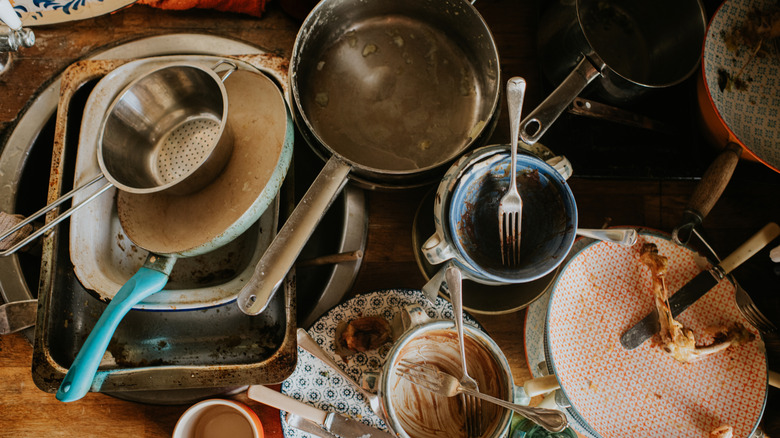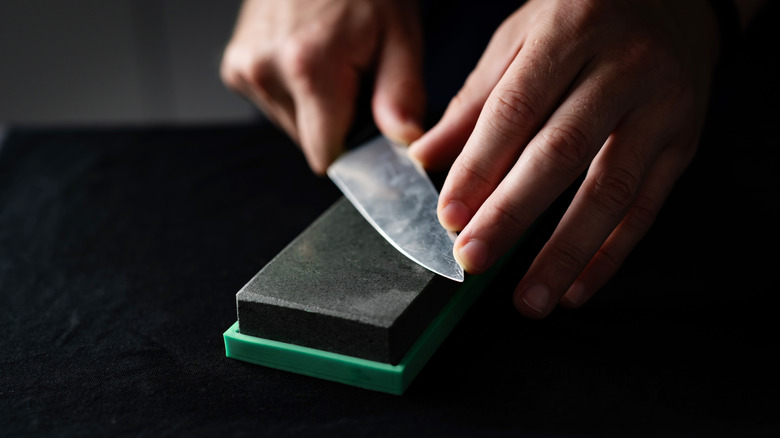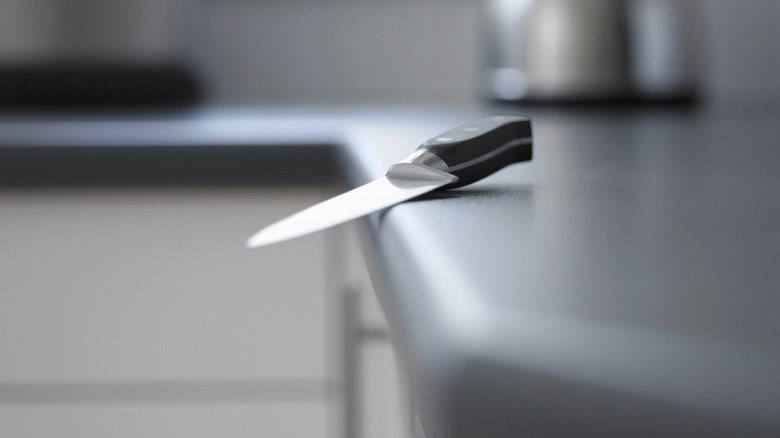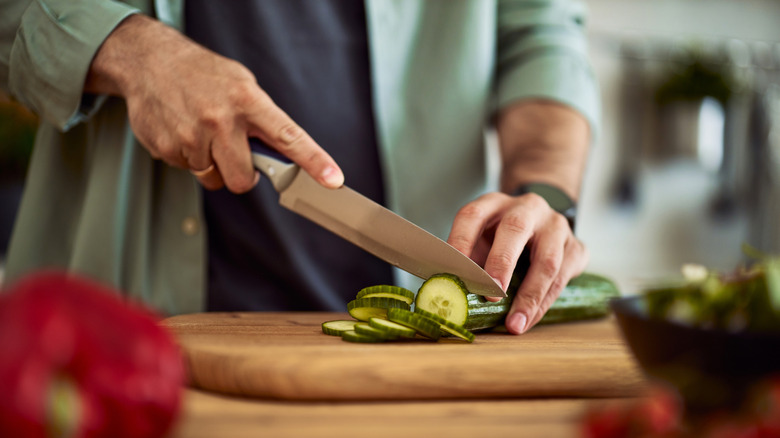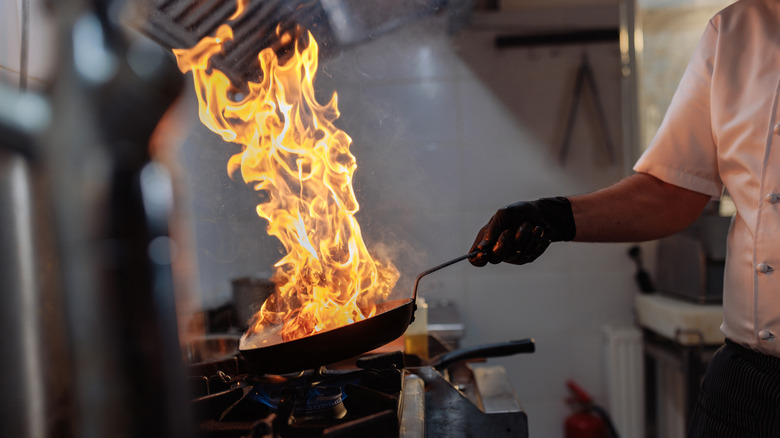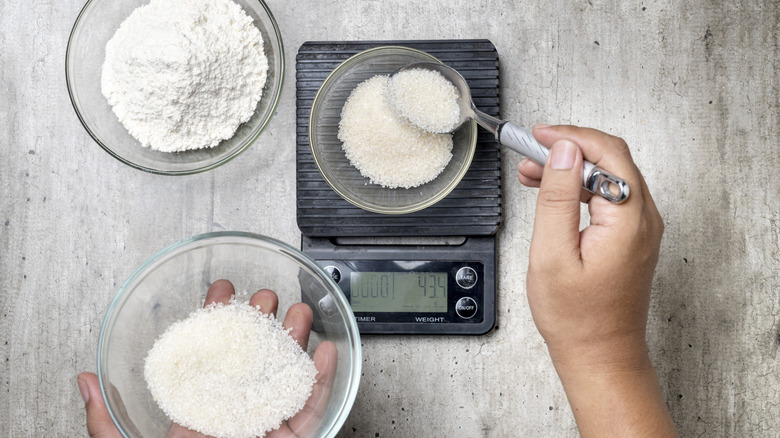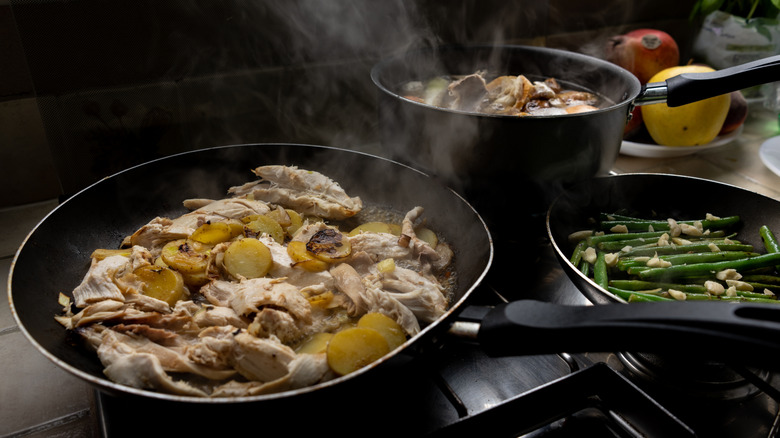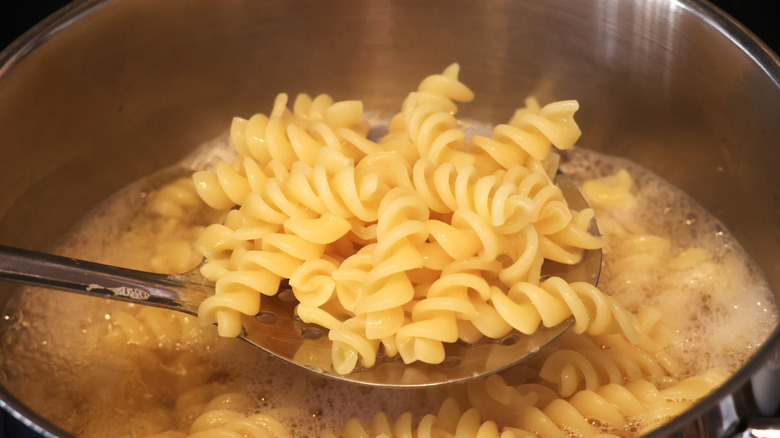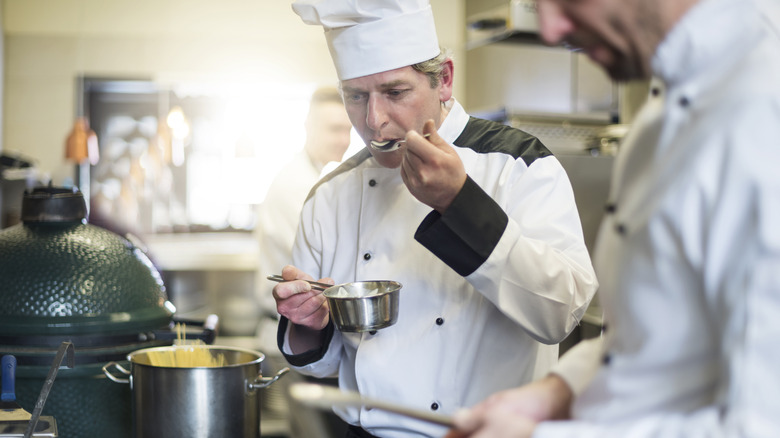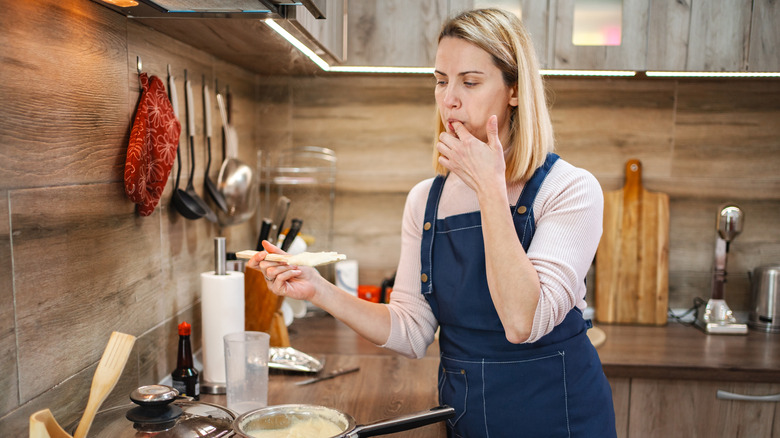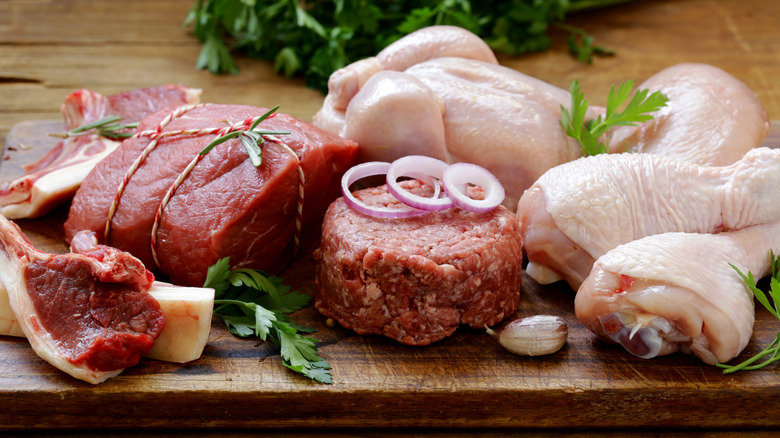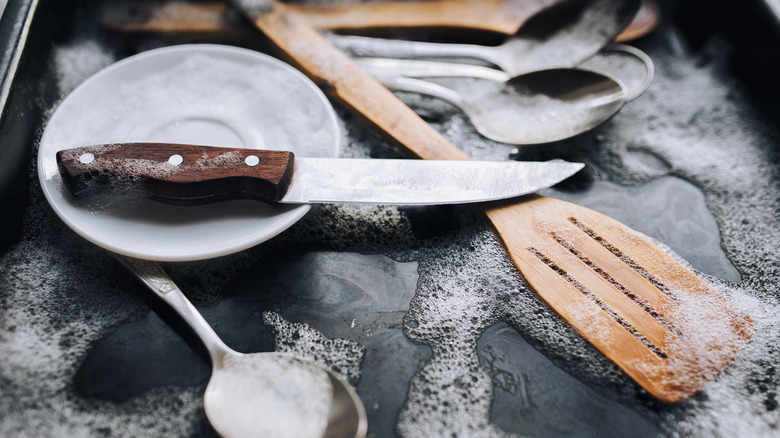13 Things You'll Never See A Professional Chef Do In The Kitchen
If you've ever gotten a glimpse into a professional kitchen, you've probably been impressed by the speed and technique playing out across the stations. Whether you peek through the kitchen doors when you're out to dinner or binge-watch old episodes of "Top Chef" to get the behind-the-scenes of famous restaurants, watching professional chefs cook in any context can amaze and inspire home cooks of any skill level.
The best professional chefs aren't just creative with their flavors and precise in their techniques. They've also overcome bad kitchen habits that make cooking even the most complex dishes a smooth and streamlined process. From never cooking in a dirty kitchen to avoiding dull knives at all costs, there's a lot that can impact your cooking beyond what happens on the stove. Everything you do in the kitchen matters. Cut these bad habits from your time in the kitchen and level up your cooking game.
Skip mise en place
One of the most important things a chef can do to make cooking easier and more fun is prepping all of their ingredients and equipment before turning on a single burner. Often known as mise en place, a French term for putting things in place, it's the very first thing professional chefs do when they get into the kitchen. In addition to getting your kitchen physically organized before you cook, mise en place also allows you to get in the headspace of cooking and avoid common recipe reading mistakes.
Mise en place goes beyond just chopping your vegetables. It involves preparing everything you'll need to seamlessly cook your dish without having to scramble for a spice or rummage through your cabinets for a spaghetti strainer. Start by reading through your recipe and gathering all of your ingredients. Wash and chop vegetables, trim meat, and measure out spices and starches. Use separate bowls for each ingredient, and arrange them in the order they'll be needed as you cook.
Next, gather all the pans, utensils, and other tools you'll need for your recipe. Make a plan for exactly what you'll use for each step of the recipe. If you need appliances like a stand mixer or a blender, make sure they're assembled, in reach, and plugged in. If your recipe has different stages, like cooking and then assembling, set up each work station before you get started.
Work on a dirty station
Keeping workstations clean is nearly as important to professional chefs as mise en place. When your stove or counter is dirty, it's harder to stay focused on the recipe and you risk mixing up or cross-contaminating your ingredients. Professional chefs are constantly wiping down their cutting board, cleaning off their knives, and tossing scraps in the garbage. Doing the same in your home kitchen puts you more in the pro chef mindset and makes clean up after dinner easier.
To make it simpler to keep your kitchen clean, start with an empty sink and clear counters. Move dirty dishes and pans to the sink and let them soak as you cook. Designate a big bowl for garbage, and set it within reach so you can toss vegetable peels, ingredient packaging, and other waste in there without breaking your stride to find the garbage can. When you have downtime in your recipe, load a few things into the dishwasher, and wipe down your counters to keep everything as clear as possible.
Cut with a dull knife
A sharp knife is a professional chef's best friend. Not only does it make food prep safer and faster, it also gives your ingredients the best possible treatment. Dull knives cut unevenly, creating tears or crushed areas that can deteriorate the flavors in your ingredients. Sharp knives, on the other hand, cut cleanly and precisely, preserving flavors and colors and giving the ingredients an elegant look on the plate.
Most home chefs don't sharpen their knives enough, making it harder for them to work in the kitchen and putting their fingertips at risk. If you're finding it hard to tell if a sharper knife would help you in the kitchen, you can test the sharpness outside of the kitchen for a neutral frame of reference. Hold a piece of plain computer paper horizontally in your nondominant hand and push your knife down through the paper several inches from your other hand. An adequately sharp knife will make an easy, smooth cut through the paper. A dull knife will struggle to cut the paper and leave rips or tears.
Try to catch a falling knife
Sharp knives might be safer than dull knives, but that doesn't mean you want to meet the business end of one. Professional chefs can use sharp knives with ease and speed because they rigorously follow knife safety rules, always maintaining an awareness of the blade and keeping their hands and fingers well clear of it. Keeping the blade pointed away from you is the most important element of knife safety, and when a knife is falling, it's impossible to keep track of which way the sharp end is facing.
Ideally, you don't drop a knife at all while cooking, but even the best chefs aren't immune to slippery fingers now and then. When you drop a knife, don't let your reflexes rule. If you reach for the knife on instinct, you're more likely than not to end up with the sharp edge cutting into your hand or fingers. Instead, train yourself to jump back from a falling knife. This way, you get far enough away that you can't reach for it automatically, and you get your feet out of the knife's path, too.
Use a rocky or uneven cutting board
Professional chefs know that a sharp knife can become as dangerous as a dull one if you're cutting on an unstable cutting board. You'll never see them cutting on an uneven surface. A cutting board that rocks or slides as you cut can put you at risk of cutting yourself, as well as making your cuts look worse. Make sure your cutting board lies perfectly flat on your counter and doesn't move away from you as you work on it.
If your only cutting board is crooked or warped (or if you have an uneven and unfixable countertop), there are a couple of easy fixes you can try if you're not ready to throw out your cutting board just yet. Sliding cutting boards can be held in place with a plastic grip mat or anything that creates a bit of friction between the board and the countertop. If rocking is your problem, try folding a dry dish towel under the highest corner. Check that the cutting board is completely secure before starting to cut in earnest.
Cook hotter to cook faster
Turning up the heat to speed up cooking time is one of the most common mistakes amateur chefs make. When you've been cooking for an hour or more and want to start eating the meal you've been working hard on, it's tempting to crank up the heat in the hopes of speeding things along. While more heat might intuitively seem like it will finish food faster, that's not always the case. For some foods, cooking hot and fast risks overcooking the outside while leaving the inside raw or underdone. For others, like chicken breast, cooking with high-heat can produce too much carryover cooking, meaning that the inside will continue to cook long after you remove it from the pan and potentially leading to dry or overcooked food.
Professional chefs have learned when cooking hot and fast is the right technique for their dish, and they can execute it with precision and care. They don't cook hot to speed up cooking, but to get a particular result. High heat is important for many tender pieces of meat, where the high temperature creates a beautiful, crispy sear, but you'll need to turn down the heat after searing to achieve the right temperature for some cuts. Practice using a meat thermometer to learn the nuances of how to vary your heat to get the perfect cook. Some sauces and sauteed vegetables also use high heat at times during cooking.
Measure by volume rather than weight or feel
Many recipes for American home cooks list ingredient quantities by cups or teaspoons, but professional chefs around the world measure their ingredients by ounces or grams. When you scoop ingredients with a measuring cup or spoon, you pack dry ingredients unevenly, making each time you measure slightly different than the one before. By using a kitchen scale to measure by weight, you can guarantee consistency every time you make a recipe. This is most important in baking, where precision is essential for perfecting tricky breads and pastries.
If you don't already have one, there are plenty of reasons to buy a kitchen scale and leave the measuring spoons behind. Measuring ingredients by weight helps you work cleanly and quickly. You don't have to hunt down every set of teaspoons in your kitchen or wonder where your ⅔ cup measure ended up. Instead, you can simply set out your kitchen scale and measure every ingredient with the same tool. You can also use your scale for portioning out leftovers, dialing in your home-brewed coffee, and more.
Crowd the pan
Just like you'll never see a professional chef defaulting to super high heat, you'll also never see them crowding as many meats and veggies as they can in a single pan. The space around food in a hot pan has almost as much influence on proper cooking as the actual temperature does, so professional chefs are sure to split their ingredients across multiple pans when it gets too full. Of course, pro chefs often have the advantage of as many different pots and pans as they need (as well as a professional dishwasher), so it doesn't mess up dishwashing when they use an extra pan. Still, the end result for your food is worth a few more dirty dishes for home cooks.
When you overcrowd a pan, whether it's with chicken thighs or chopped squash, you make it more difficult to get your ingredients to the right temperature to brown or sear them. A crowded skillet traps steam as food heats up, leading to a poached or steamed effect rather than crispy, delicious browning from the Maillard reaction. You don't have to leave a ton of space between each piece of food, but the edges of your meat or vegetables mostly shouldn't be touching each other, leaving small gaps for steam to leave the pan.
Put oil in pasta water
Some home chefs have a habit of adding oil to their pot of pasta water in an effort to keep their pasta from sticking as it cooks. The oil does prevent sticking while the pasta is in the pot, but you still won't find professional chefs using this trick. That's because the oil doesn't just prevent pasta from sticking to itself. It also prevents sauce from sticking to the noodles, resulting in a sloppy, soupy pasta dish rather than the nicely-coated noodles you'll find in a restaurant.
To get your sauce sticking to your pasta the way the professionals do, aim for starch in your pasta water rather than oil. The starch helps bind and thicken your sauce as you finish your pasta dish, so be sure to save your pasta water until you're completely done cooking in case you need a little extra liquid. You can prevent noodles from sticking to each other by stirring as it cooks, and making sure to pull your pasta out of the boiling water before it overcooks.
Serve a dish without tasting it
If you've ever watched a cooking competition, you know that forgetting to taste a dish is one of the biggest ways a professional chef can get themselves in hot water. Professional chefs taste their food almost constantly throughout cooking, looking for any seasoning adjustments that need to be made as they build layers of flavor into the dish. They'll taste each component of their dish at every stage of cooking, and then taste them all together to be sure everything is perfect before they send it out of the kitchen.
For most chefs, tasting for seasoning or texture is different from eating a meal for enjoyment. They take small bites, allowing the flavors to spread over their palate and giving them time to consider what the dish needs. Chefs might add more salt or spice, or might find they've gone overboard and need to fix a salty dish. Professional chefs also pay attention to texture, like if a sauce is too thick or thin, so they can adjust accordingly. One adjustment often leads to another, which is why tasting has to happen throughout cooking, not just once or twice.
Taste with their fingers or double dip a utensil
Although you will see professional chefs taste their food all their time, you'll never see them lick their fingers or reuse a spoon to do so. In decades past some kitchens might have allowed such a practice, but today using your fingers or double dipping a spoon is unacceptable in any professional kitchen. In addition to being a health and sanitation risk, it's also just gross.
Home chefs don't have to worry about sanitation to the same level as professional chefs, but getting in the habit of using designated tasting spoons will still level up your cooking game. Keep a spoon or fork near your cooking station and transfer food to it from your utensils so you can taste while avoiding a double dip. Or, invest in a set of smaller dedicated tasting spoons so you can use several as you cook, then throw them in the dishwasher for easy cleaning.
Let cooked and uncooked components mix
Professional chefs are hyper-aware of food safety, and are sure to handle separate ingredients carefully to avoid cross-contamination between components of their dish. Most often, this means keeping raw and cooked ingredients separate, especially when you're dealing with raw meat. Juices or debris from raw meat can cling to cutting boards, knives, or other kitchen surfaces and cause illness if ingested, so be sure to wash any equipment that may have come into contact with raw meat.
Thinking about cross-contamination starts well before you start cooking. You can and should practice raw food safety starting in the grocery store. Keep raw meat and seafood separate from ready-to-eat ingredients as you organize your shopping cart, and make sure they're tightly wrapped to avoid any leaking juices. Maintain this separation when you store food in your refrigerator, and whenever you cook, to get your food safety level to that of a professional chef.
Leave dirty knives in the sink
There's one last knife safety protocol professional chefs follow religiously, and that has to do with how they handle dirty knives. Professional chefs take a great deal of care with their set of knives, keeping them sharp and often cleaning them right after use. You'll never see a professional chef leaving their dirty knife in the bottom of the sink.
If you leave a dirty knife in the sink, you risk more than just damage to your knife. In a full or crowded sink, a knife becomes incredibly dangerous to you or anyone trying to wash dishes. When you reach into the sink or soapy water, you might unknowingly grab the sharp end of the knife and cause injury. It's even more important to keep your knives out of the sink in a shared kitchen, where someone else might reach into the sink without knowing you've put your knife there.

